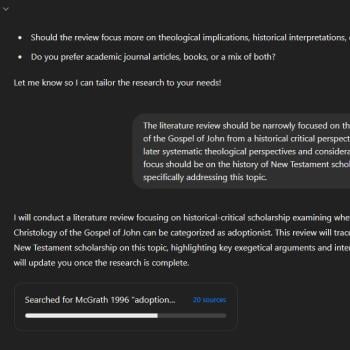Pat McCullough has a couple of posts on his blog in which he treats historical Jesus research as “futile.”
 If one is of the view that all attempts at knowing about the past are so complicated by our inability to infallibly separate memory from invention, or to attain absolute certainty, then by all means dismiss not just historical Jesus research but most if not all attempts to know about the past.
If one is of the view that all attempts at knowing about the past are so complicated by our inability to infallibly separate memory from invention, or to attain absolute certainty, then by all means dismiss not just historical Jesus research but most if not all attempts to know about the past.
But the reasoning that Pat uses is along different lines, and does not, I think, do justice to the situation.
The diverse conclusions drawn by researchers investigating the historical figure of Jesus is, at worst, an indication that historical methods do not successfully counter our penchant for making Jesus as we desire him to be. Diverse Jesuses (or Jesi, as Kate Dailey-Bailey prefers) are to be found as far back as we have literature about Jesus. And we could say the same about Socrates.
But even our earliest portraits are not infinitely diverse. There are commonalities which indicate that there were constraints of memory and tradition at work, which counterbalanced to at least some extent the penchant to invent, to make a figure a spokesperson for one’s own ideas.
 There is another possible reason for the diversity of portraits of the historical Jesus offered by academics. One pole of the scholarly enterprise is to come up with something new, and thus worthy of publication.
There is another possible reason for the diversity of portraits of the historical Jesus offered by academics. One pole of the scholarly enterprise is to come up with something new, and thus worthy of publication.
Given the degree of interest, professional as well as popular, in the figure of Jesus, the sheer number of scholars working on historical questions related to him are not only bound to, but required to by their doctoral supervisors and later their employers, to come up with new things.
But those who work in academia know that not every new proposal is worth accepting. And so when some people (whether conservative or liberal believers, or mythicists, or anyone else) latch onto a marginal scholarly viewpoint because it fits their worldview, that is a problem not with historical investigation, but with the fact that many people outside of the academy misunderstand the scholarly enterprise as one in which either everyone should all say the same thing, or otherwise nothing is certain, and one can just pick and choose from among the scholars whichever view confirms one’s own assumptions).
That is why grasping the notion of scholarly consensus is crucial. When there is extensive agreement among experts in a field, despite our need to innovate, then it is likely that that consensus is based on substantial and convincing evidence. When there is widespread disagreement not only in the latest monographs seeking to innovate, but in textbooks and other places where one would expect to see a consensus viewpoint articulated, that probably indicates that the evidence does not clearly point to one particular conclusion.
 We can see that in the case of plenty of historical figures. What they said may be known with a high degree of certainty, but even then, what they meant, what they intended, is regularly construed in more than one way.
We can see that in the case of plenty of historical figures. What they said may be known with a high degree of certainty, but even then, what they meant, what they intended, is regularly construed in more than one way.
Scholarship involves connecting the dots between pieces of evidence, and often this can be done in more than one way. The fact that one can configure things that Jesus almost certainly said in different arrangements and thus different overall portraits does not mean that there are not things that he almost certainly said.
And so, from my own perspective as someone who works in the field of historical Jesus research, I have to say that it does not seem at all futile to me. Indeed, the application of historical methods is one of the only things that has shown itself to be able, to at least some extent, to counteract the penchant for simply inventing a Jesus of one’s own imagining. The evidence does not constrain human imagination to such an extent that it is impossible to come up with different interpretations. But without historical constraints, the human imagination would simply be free to invent without any voices to protest, and without any basis for doing so.
What does sometimes seem futile – but I continue to hope and believe is not – is the attempt to communicate to the wider public how historical scholarship works, and how to make sense of the things they read and hear from the academy.
If I thought that was futile, after all, then I wouldn’t have bothered writing this post.












